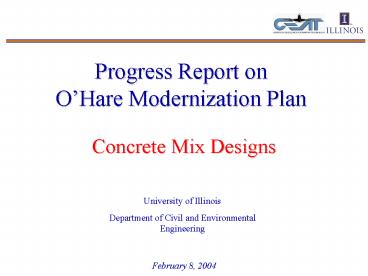Progress Report on OHare Modernization Plan - PowerPoint PPT Presentation
1 / 38
Title:
Progress Report on OHare Modernization Plan
Description:
Max. lch (ductility) Max. Gf (Crack resistance) Mechanical Properties. 1. Objectives ... Initial Mix and Testing Methods Evaluation ... – PowerPoint PPT presentation
Number of Views:62
Avg rating:3.0/5.0
Title: Progress Report on OHare Modernization Plan
1
Progress Report on OHare Modernization
Plan
Concrete Mix Designs
University of Illinois Department of Civil and
Environmental Engineering
February 8, 2004
2
Concrete Mix Design Team
- Prof. David Lange
- Concrete materials / volume stability
- High performance concrete
- Prof. Jeff Roesler
- Concrete pavement design issues
- Concrete materials and testing
3
Graduate Research Assistants
- Cristian Gaedicke
- Concrete mix design / fracture testing
- Sal Villalobos
- Concrete mix design and saw-cut timing
- Rob Rodden
- testing, instrumentation, shrinkage
- Zach Grasley
- Concrete volume stability
4
Overview of Project Objectives
- Mix Design
- Minimize cracking potential
- Short and long-term
- Minimize Shrinkage
- Joint Enhancement
- Aggregate Interlock
- Targeted dowel placement
5
Completed Activities
- Survey of Existing Concrete Mixes
- Initial Mix and Testing Methods Evaluation
- Technote Shrinkage Reducing Admixtures in
Concrete Pavements - Technote Fiber-Reinforced Concrete Pavements
6
Survey of Existing Mixes
7
Survey of Existing Mixes
8
Initial Mix Evaluation
- Mix used in previous projects at OHare
- Revised Mix 1905 (2000)
9
Common Strength Tests
Compressive strength and Concrete elastic modulus
3rd Point Loading (MOR)
10
Standard Concrete Shrinkage
Concrete shrinkage prism ASTM C157
Mortar Bar shrinkage ASTM C596
11
Initial Mix Evaluation
- Compressive strength ? 4470 psi _at_ 7days
- Modulus of Rupture ? 380 psi _at_ 7days
- Drying shrinkage ? 440 mm
- Autogenous shinkage ?170 mm
- Instrumented cube (measurement of RH and Temp.)
12
Fracture vs. Strength Properties
MOR
GF
- Peak flexural strength (MOR) same but fracture
energy (GF) is different - Avoid brittle mixes
13
Fracture Test Setup
Notched Beam Test
Wedge Split Test
14
Wedge Split Test Result
- The concept of GF
- Wedge split Gf and lch EGf/ft2
15
Effect of Aggregate Type on GF
16
Benefits of SRA in Pavements
- Reduced Shrinkage and Cracking Potential
- Near 50 60 reduction
- Increased Joint spacing
Brooks et al. (2000)
17
Problems of SRA in Pavements
- Technical
- Early age strength loss
- Delay in set time
- Interaction with air entrainment admixture
- Potentially washout with water
- Economic
- Cost
18
Fiber-Reinforced Concrete Pavements
- Application of low volume, structural fibers
19
Benefits of FRC Pavements
- Increased flexural capacity and toughness
- Thinner slabs
- Increased slab sizes
- Limited impact on construction productivity
- Limits crack width
- Promotes load transfer across cracks (?)
20
Use of FRC in Pavements
- Fiber-reinforced concrete
- Final cost reduction of 6 to an increase of
11
21
Testing Program
- Variables- Phase I
- Proposed Variables- Phase II
22
Testing Factorial
- Where
- fc7 compressive strength at 7 days
- E 7 modulus of elasticity at 7 days
- Gf 7 energy release rate at 7 days
- sfl 7 flexural strength at 7 days
- ssp 7 splitting strength at 7 days
- esh drying shrinkage
- eas autogenous shrinkage
- 28-day properties
- Fracture Energy
23
Joint Type Selection
- Are dowels necessary at every contraction joint?
24
Aggregate Interlock Joint
- Dummy contraction joint
- No man-made load transfer devices
- Shear transfer through aggregate/concrete surface
- aggregate type and size joint opening
25
Joint Design
- Saw-cut timing
- Aggregate
- Interlock
- Targeted
- Dowels
26
Joint Design
- Promote high shear stiffness at joint
- High LTE
- Larger and stronger aggregates
- Increase cyclic loading performance
- Predict crack or joint width accurately
27
Effect of Concrete Mix on GF
38mm Trap Rock
38 mm Gravel
25mm Trap Rock
25mm Gravel
25mm Gravel
25mm Limestone
28
- GF and Shear Load Transfer
- Shear load transfer depends on GF at 28 days.
- Concrete with high GF at 28 days provides good
shear load transfer across cracks/joints.
29
- AGGREGATE TYPE
-
TRAP ROCK
gt RIVER GRAVEL
gt LIMESTONE
30
- AGGREGATE GRADATION
-
Gradation doesnt have much impact.
31
- AGGREGATE SIZE
LARGE BETTER THAN SMALL
(38MM)
(25MM)
32
Other significance of GF
- GF better characterize the effect of CA on
concrete performance. - w/c 0.49
- ? fc (12 hrs) 3.80 4.20 MPa
- ? fc (28 days) 31.7 38.1 MPa
- ? GF (12 hrs) 52.7 194.5 N/m
- ? GF (28 days) 93.7 573.3 N/m
33
Saw-cut Timing and Depth
- Notch depth (a) depends on stress, strength, and
slab thickness (d) - Stress f(coarse aggregate,?T, RH)
34
Requirements for Saw-cut Timing
Stress
Strength
s
Time
- Stress f(thermal/moisture gradients, slab
geometry, friction) - Strength (MOR,E) and fracture parameters (Gf or
KIC) with time
35
Project Goals
- Crack-free concrete (Random)
- Specification for shrinkage
- Specification for GF
- Specifiction for MOR
- Optimal joint type
- Aggregate Specification
- Stabilized base
- Saw-cut timing
- Cost effective!
- Minimum Quantity of Cement
- Improvement of Aggregate Interlock
36
Concrete Mix Design
- Minimum strength criteria (MORmin)
- Minimum fracture energy (GF)
- Max. concrete shrinkage criteria (?sh)
- Aggregate top size (Dmax)
- Strong coarse aggregate (LA Abrasionmax)
- Saw-cut timing table
- Slow down hydration rates and temperature
37
Summary of Progress
- Concrete Mix Survey Technote
- FRC Technote
- SRA Technote
- Initial Mix Evaluation
- Phase I - Testing Program
- Saw-Cut Timing
38
- Questions































